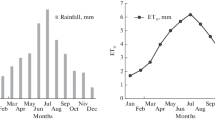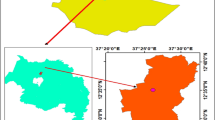Abstract
Crop simulation models of different complexity have been developed for predicting the effects of soil, water and nutrients on growth and water productivity of different crops. These models are calibrated and validated for a given region using the data generated from field experiments. Therefore, AquaCrop model was calibrated and validated for grain maize (Single Cross 260) under varying irrigation and nitrogen levels. The experiment was conducted at the research farm of the agricultural college, Islamic Azad University, Shiraz during summer season 2011 and 2012. Irrigation treatments consisted of different levels of depletion of available soil water. The four levels of moisture depletions considered in the study were 20, 40, 60 and 80 percent. Nitrogen application levels were 150 (N1), 200 (N2), 250 (N3) and 300 kg ha–1. Root Mean Square error (RMSE), Prediction error (Pe), coefficient of determination (R2) and normalized root mean square error (RMSEn) were used to test the model performance. The model was calibrated for simulating maize grain and biomass yield for all treatment levels with the prediction error 4 < Pe < 5 per cent, 0.64 < R2 < 0.81 and 469 < RMSE < 786 t ha–1. Upon validation, Pe between 10 and 6; R2 between 0.65 and 0.76 and RMSE between 1062 and 1293 for grain and biomass yield, respectively. The highest and the lowest accuracy to predict yield and biomass under all nitrogen levels was obtained at I1 (MAD: 20%) and I4 (MAD: 80%) treatments, respectively. The results of the present study show that the AquaCrop model simulates aboveground biomass more accurately than grain yield. Also, model cannot provide satisfactory results under severe water stress conditions.




Similar content being viewed by others
REFERENCES
Abedinpour, M., Sarangi, A., Rajput, T.B.S., Man, S., Pathak, H., and Ahmad, T., Performance evaluation of AquaCrop model for maize crop in a semi-arid environment, Agric. Water Manage., 2012, no. 110, pp. 55–66.
Abedinpour, M., Sarangi, A., Rajput, T.B.S., and Singh, M., Prediction of maize yield under future water availability scenarios using the AquaCrop model, J. Agric. Sci., 2014, no. 152, pp. 558–574.
Allen, R.G., Pereira, L.S., Raes, D., and Smith, M., Crop evapotranspiration: Guidelines for computing crop water requirements, FAO Irrig. Drain. Pap., 1998, no. 56.
Araya, A., Habtu, S., Hadgu, K.M., Kebede, A., and Dejene, T., Test of AquaCrop model in simulating biomass and yield of water deficit and irrigated barley, Agr-ic. Water Manage., 2010, no. 97, pp. 1838–1846.
Debaeke, P. and Aboudrare, A., Adaptation of crop management to water-limited environments, Eur. J. Agron., 2004, no. 21, pp. 433–446.
FAO. 2008. Hot Issues: Water Scarcity 2008. http://www.fao.org/nr/water/issues/scarcity.html. Accessed July 24, 2011.
Fereres, E.M. and Soriano, A., Deficit irrigation for reducing agricultural water use: Integrated approaches to sustain and improve plant production under drought stress special issue, J. Bot., 2007, no. 58, pp. 147–159.
Heng, L.K., Hsiao, T.C., Evett, S., Howell, T., and Steduto, P., Validating the FAO AquaCrop model for irrigated and water deficient field maize, Agron. J., 2009, no. 101, pp. 488–498.
Hsiao, T.C., Heng, L.K., Steduto, P., Rojas-Lara, B., and Raes, D., Fereres. E. AquaCrop—the FAO crop model to simulate yield response to water: III. Parameterization and testing for maize, Agron. J., 2009, no. 101, pp. 448–459.
Jamieson, P.D., Porter, J.R., and Wilson, D.R., A test of the computer simulation model ARC-WHEAT1 on wheat crops grown in New Zealand, Field Crops Res., 1991, vol. 27, pp. 337–350.
Jones, C.A. and Kiniry, J.R., Ceres-N Maize: A Simulation Model of Maize Growth and Development, Temple, TX: Texas A&M Univ. Press, 1986.
Pereira, L.S., Irrigated agriculture: Facing environmental and water scarcity challenges, International Symposium on Water and Land Management for Sustainable Irrigated Agriculture, Cukurova Univ., 2006.
Raes, D., Steduto, P., Hsiao, T.C., and Fereres, E., AquaCrop—the FAO crop model to simulate yield response to water: II. Main algorithms and soft ware description, Agron. J., 2009, no. 101, pp. 438–447.
Steduto, P. and Albrizio, R., Resource-use efficiency of field-grown sunflower, sorghum, wheat and chickpea. II. Water use efficiency and comparison with radiation use efficiency, Agric. For. Meteorol., 2005, no. 130, pp. 269–281.
Steduto, P., Hsiao, T.C., and Fereres, E., On the conservative behavior of biomass water productivity, Irrig. Sci., 2007, no. 25, pp. 189–207.
Steduto, P., Biomass water-productivity. Comparing the growth-engines of crop models, FAO Expert Meeting on Crop Water Productivity under Deficient Water Supply, Rome, 2003.
Steduto, P., Hsiao, T.C., Raes, D., and Fereres, E., AquaCrop—the FAO crop model to simulate yield response to water: I. Concepts and underlying principles, Agron. J., 2009, no. 101, pp. 426–437.
Stockle, C.O., Donatelli, M., and Nelson, R., CropSyst, a cropping systems simulation model, Eur. J. Agron., 2003, no. 18, pp. 289–307.
Stricevic, R., Cosic, M., Djurovic, N., Pejic, B., and Maksimovic, L., Assessment of the FAO AquaCrop model in the simulation of rainfed and supplementally irrigated maize, sugar beet and sunflower, Agric. Water Manage., 2011, no. 98, pp. 1615–1621.
Teklu, E. and Seleshi, B.A., Soil fertility effect on water productivity of maize and potato, AquaCrop Workshop, Cairo, 2009, pp. 25–29.
Yang, H.S., Dobermann, A., Lindquist, J.L., Walters, D.T., Arkebauer, T.J., and Cassman, K.G., Hybrid-maize—a maize simulation model that combines two crop modeling approaches, Field Crops Res., 2004, no. 87, pp. 131–154.
Zeleke, K.T., David, L., and Raymond, C., Calibration and testing of the FAO Aqua Crop Model for canola, Agron. J., 2011, no. 3, pp. 1610–1618.
Author information
Authors and Affiliations
Corresponding author
Ethics declarations
The authors declare that they have no conflict of interest. This article does not contain any studies involving animals or human participants performed by any of the authors.
About this article
Cite this article
Amiri, E., Abedinpour, M. Simulating Maize Yield Response to Depletion of Available Soil Water and Nitrogen Management under Drip Irrigation with the FAO AquaCrop Model. Russ. Agricult. Sci. 46, 602–608 (2020). https://doi.org/10.3103/S1068367420060038
Received:
Published:
Issue Date:
DOI: https://doi.org/10.3103/S1068367420060038




